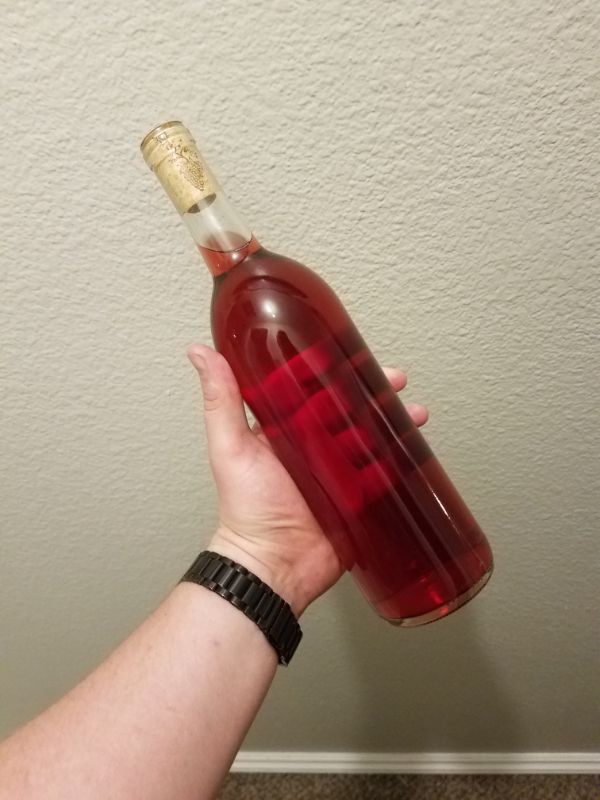Twin recipes for blueberry mead and cherry mead. Each mead uses all-natural fruit concentrates as their base, which are often more affordable than fresh or frozen fruit, or bulk juice.
Originally Posted: Aug. 7, 2020
Last Updated: Apr. 2, 2021


Table of Contents
Quick Specs
- OG = ~1.105
- ABV: ~13%
- Taste Profile: Light to medium fruit flavor in both cases
- Time: 6 months to a year
- Batch size: 5-gallon (both)
- Yield: ~25 bottles each
Intro
I’ve decided to post about these two melomels together because I used nearly identical brewing processes, aside from how I treated the fruit. I found a brand of all-natural juice concentrate on Amazon called Country Spoon. The added sugars from the concentrate were negligible, so I went for a full 15 lbs. of honey in both cases. This led to future hubris when I tried using Vintner’s Best fruit wine base the same way on two meads later, but that’s a story for another time. Country Spoon is a nice basic concentrate to use for a mead.
I’m an advocate of using juice concentrates in my brews, especially in cases where using fresh fruit would be cost-prohibitive. However, always check what ingredients are in your concentrate and then use your best judgment. Some concentrates have negligible amounts of added sugar, while some concentrates are full of corn syrup. I’ve found the latter to be the case when dealing with concentrates meant to be used as fruit wine bases; they already have plenty of sugar in them, so adding honey could put stress on your yeast through osmotic pressure.

Ingredients
- Both:
- 15 lbs. clover honey, step-fed
- 5 gallons of spring water
- Lalvin D-47 yeast
- Yeast nutrient
- Blueberry Mead:
- Country Spoon Blueberry Juice Concentrate
(unfortunately I’m unable to find their blueberry concentrate anymore, so next time I think I’ll try this one)Note: looks like it’s available again 🙂 - Frozen hand-picked blueberries from a patch out in North Bend, WA
- Country Spoon Blueberry Juice Concentrate
- Cherry Mead:
- Country Spoon Cherry Juice Concentrate
- Lacto-fermented cherries, pit-in
- Oak cubes for aging
Equipment
- Sanitizer
- Fermenter
- Airlock and stopper
- Sous vide circulator (optional, to warm the honey)
Instructions
Blueberry
For this one, I had picked blueberries myself at a blueberry farm out in North Bend, WA. Then I had frozen them, both to kill off any wild yeast living on the berries and to break open the cell walls to allow juice and yeast to flow through the fruit better.
Next time I do a blueberry mead, I think I’ll simmer the frozen blueberries in a little bit of water and possibly some sugar to see if it will impart a more intense blueberry flavor.
- Warm honey via your preferred method.
- Mix your entire bottle of Country Spoon blueberry concentrate, spring water, and 10 lbs. of honey.
- Add your choice of yeast and take a gravity reading.
- When fermentation slows, add remaining 5 lbs. of honey.
- Once fermentation slows again, rack mead into new sanitized container containing thawed blueberries. Age for several more weeks or months (take tastings and gravity readings and use your best judgment).



Cherry
For this one, I tried to lacto-ferment the cherries (pit-in) in a salt brine first. I was hoping for a light, sour and salty gose-like taste, though it wasn’t nearly as pronounced as I would’ve liked. It might’ve been more sour-salty if I’d poured all of the brine into the fermenter along with the cherries. Still turned out to be a good way to preserve the cherries until I needed them, and I was reasonably certain that the only microbes left on the cherries afterward were lactobacillus species.
An alternative would be to simmer some frozen cherries in a little bit of water and maybe some sugar to extract a more intense cherry flavor.
- Warm honey via your preferred method.
- Mix your entire bottle of Country Spoon cherry concentrate, spring water, and 10 lbs. of honey.
- Add your choice of yeast and take a gravity reading.
- When fermentation slows, add remaining 5 lbs. of honey.
- Once fermentation slows again, rack mead into new sanitized container containing cherries. Age for several more weeks or months (take tastings and gravity readings and use your best judgment).
- Once you’ve gotten a cherry taste that you like, rack off of cherries and onto sanitized oak cubes to impart some oak flavor. You could also add the oak at the same time as the cherries; some experimentation would be beneficial here. Age on oak cubes for a few weeks, taking regular tastings.

Possible Culinary Uses
I think both meads would be a good choice to make a reduction sauce from. The sauce could be drizzled over cheesecake, ice cream, or even meats and fishes.




